David Sandved
David Sandved (17 September 1912 – 8 March 2001) was a Norwegian architect.
David Sandved | |
|---|---|
| Born | 17 September 1912 Sandnes, Norway |
| Died | 8 March 2001 (aged 88) Haugesund, Norway |
| Nationality | Norwegian |
| Citizenship | Norwegian |
| Occupation | Architect |
| Spouse(s) | 1938–1947 Sonja Haugan [1]
1948– Marit (maiden name Furulund) Sandved [1] |
| Parent(s) | Father Søren Sandved (1884–1946) and mother Berta Mouland (1885–1966) [1] |
Life and work
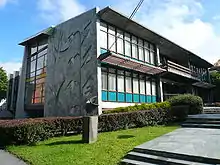
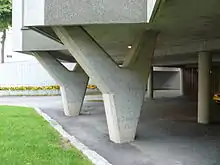
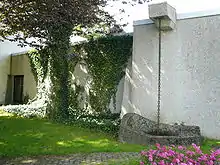
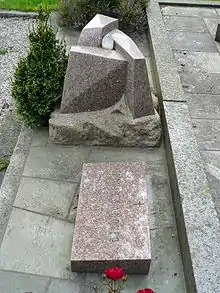
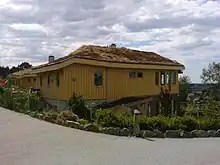
He was born in Sandnes and received his architectural education at the Norwegian Institute of Technology in 1937. He established his own practice in Haugesund. His architecture developed from classical modernism to a form of critical regionalism, using local building motifs and symbols. In 1948 he moved from Oslo to Haugesund to work on ship interiors. He made all the interiors for Christian Haaland's new freight liner's, the «Concordia Line». He designed many different building types, including public, commercial, residential buildings. Sandved was working as an architect to the late 1980s.
From 5 February 1948 to his death he was married to Marit (b. Furulund) Sandved (1918–2009).[2] In the 1950s he was strongly influenced by Rudolf Steiner and his anthroposophy. Sandved also participated actively in the public sphere, defending the composer Fartein Valen and his atonal polyphonic music in the local newspapers. In the 1990s the painter Odd Nerdrum discovered that David Sandved was his biological father.[3][4][5]
Selected works
Residential buildings
- Villa for Direktør Hilmar Onarheim, "Onalund", Valevegen 7, Hystad, Stord (1952).
- Villa for Doctor Simonsen, Breidablikkgaten 217, Haugesund (1957).
- Villa for Lawyer Arne Lothe, Asalvikvegen 17, Haugesund (1961).
- Villa for Doctor Sven Svensen, Skudenesgaten 14b, Haugesund (1966)
- Villa, Vestevegen 45, Haugesund.
- Villa for Shipowner Rasmussen, Salhusveien 15, Haugesund.
- Villa, Kong Sulkes gate 1, Haugesund.
- Villa, Norrønagata 26, Haugesund.
- Villa, Vestevegen 41, Haugesund (1968).[6]
- Presthaug Apartment blocks (Haubo), Presthaugvegen 1-4, Haugesund (1970).
- Ramsdalen Apartment blocks, Haakonsvegen 65, 69, 71, 73 and Solvangveien 45 (1971)
Industrial buildings
- Haugesund Mekaniske Verksted, administration building, Jens Risøens gate 72, Haugesund (1964)
Public buildings
- Extension of Hauge Primary school, Haugevegen 31, Haugesund (1954).[7]
- Haugesund Maritime High school (Karmsund videregående skole), Maskinistskolen, Salhusveien 68, Haugesund (1966).
- Haugesund Maritime High school (Karmsund videregående skole), Haugesund kokke- og stuertskole, Salhusveien 68, Haugesund.
- Haugesund Public library, Kirkegata 151, Haugesund (1967).
- Haraldshallen (sports arena), Hanne Hauglands veg 10, Haugesund (1969).
- Haraldsvang Secondary school, Hanne Hauglands veg 9, Haugesund (1967).[8]
- Saltveit Primary school, Tittelsnesvegen 332, Haugesund.
- Haugesund Lillebo institution for mental retarded children, Floraveien 15, Haugesund (1974).
- Haugesund Art Gallery (Haugesund Billedgalleri), Erling Skjalgsonsgate 4, Haugesund (1977–1978).[9]
- Extension of Solvang Secondary school, Hervikvegen 14, Haugesund (1978/79).[10]
- Turnhallen (Gymnastics hall), Hanne Hauglands veg 8, Haugesund.
- Gymnastics- and stage building for Rudolf Steiner School in Haugesund, Skjoldavegen 175, Haugesund.
- Soria Moria Steiner preschool, Skjoldavegen 173, Haugesund.
Commercial buildings
- Svelland building, Haraldsgaten 140, Haugesund (1965).
- Krohn Brekkebuilding (Cubus), Haraldsgaten 132, Haugesund (1966).
- Sjøhuset (Kyvik), Møllerveien 22, Haugesund (1965–1971).
- Victoriahjørnet (for Christian Haaland), Haraldsgaten 139, Haugesund (1977).
- Bookshop Nils Sundt, Haraldsgaten 159, Haugesund (1978).
- Haugesund Savings Bank, Haraldsgaten 115, Haugesund.
Other works
- «The Norwegian motif», Europe square (Place de l'Europe) at the Europe tower (Tour de l'Europe) in Mulhouse, France, stone mosaic consisting of 7 different types of marble. The motif shows four birds with symbols of grain, fish, wood and electricity (1964).
- Decorated jewellery boxes, Haugesund Mekaniske Verksted, gifts for naval christenings.
Selected bibliography
- David Sandved, Har vi bruk for en åndsvitenskap? 1999
- David Sandved, Bål ved veien, Dreyer Forlag 1948
- David Sandved, Boka om fargene, Tanum 1946
Literature
- Søndenaa, Marit; Arkitekt David Sandved, 1981
References
- Møller, Trygve Juul (1957). Studentene fra 1932 – Biografiske opplysninger, statistikk og artikler samlet til 25 års jubileet 1957 (in Norwegian). Bokkomiteen for studentene fra 1932. pp. 324–325.
- Oddenes, Ole (2005-04-28). "En bit av gravstøtten stjålet" (in Norwegian). Haugesunds Avis. Archived from the original on 2019-07-10. Retrieved 2009-01-22.
Arkitekt David Sandveds grav […] Marit Sandved, enken etter den kjente arkitekten, […] hugget i rød granitt av Ivar Rudi,
- Vine, Richard (2001). Odd Nerdrum: Paintings, Sketches and Drawings. Oslo: Gyldendal Norsk Forlag AS, Gyldendal Fakta. p. 26. ISBN 82-05-32997-4.
- "Nerdrums vonde barndom: Fant sin far etter 48 år" (in Norwegian). Verdens Gang. 1996-11-30. Retrieved 2009-01-28.
Odd Nerdrum (52) møtte sin biologiske far, arkitekten David Sandved (81), for første gang høsten 1992.
- "Sammen i pappas hus" (in Norwegian). Verdens Gang. 1997-09-25. Retrieved 2009-01-28.
Første bilde av Odd Nerdrum sammen med faren IN: HAUGESUND (VG) Dette er et historisk bilde: maleren Odd Nerdrum sammen med sin biologiske far, arkitekten David Sandved i galleriet som er tegnet av faren.
- Jacobsen, Irene (2017-02-10). "- Møbler bør minst vare i to generasjoner. Jeg blir helt stressa av alle som skifter stil og møbler hvert femte år". bt.no. Archived from the original on 2017-02-10. Retrieved 2017-02-10.
Huset fra 1968 har alle de tidstypiske elementene på plass. Teak, Biritapet, fargede veggplater, store vinduer, eik, linoleum – og enkelte ting som er typisk Sandved – som for eksempel trapperekkverket i gangen. Han brukte samme sorten rekkverk på folkebiblioteket i byen.
- "Hauge skole "på Haugå"" (in Norwegian). Haugesunds Dagblad. Archived from the original on 2007-09-29. Retrieved 2007-06-05.
Skolens ulike byggetrinn ble i 1954 knyttet sammen med et "mellombygg" tegnet av arkitekt David Sandved som innholdt 12 klasserom.
- Dalen, Hans A (2004-11-08). "Litt historikk:" (in Norwegian). Haugesund municipality. Archived from the original on 2007-10-26. Retrieved 2007-08-02.
Arkitekt David Sandved var den som tegnet skolen. Det er samme mann som har bestemt utseende og form på de figurer som er støpt i betongveggene. Disse figurene finner vi igjen i skolefanen.
- "Fakta om museet – Museets arkitektur" (in Norwegian). Haugesund Billedgalleri. Archived from the original on 2008-07-25. Retrieved 2009-01-28.
Arkitekter: David Sandved og arkitektkontoret Sandved og Wathne arkitekter AS.
- "BYGNINGER OG SKOLEOMRÅDE" (in Norwegian). Haugesund municipality. Archived from the original on 2007-12-10. Retrieved 2007-08-02.
og i 1978/79 ble Nyeskolen bygget - tenkt som en to-parallellers barneskole. Arkitekt David Sandved ga skolebygningen en særpreget ytre arkitektur og en framtidstenkt, fleksibel planløsning innvendig.
External links
- Arkitekter: David Sandved (1912-2001)
- Nasjonalbiblioteket – David Sandved
- List of publications by David Sandved in BIBSYS (Norway)
- Haugesund Art Gallery